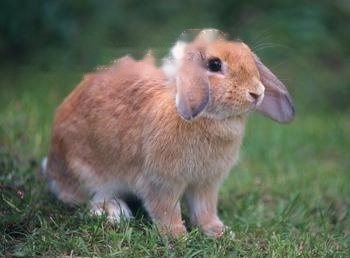
American Mini Lop
American Mini Lop Rabbit, also commonly known as Binny lop, small lop or pygmy lop.
English name: English Lop
Personality: Tame
Origin: Algiers, Africa
Lifetime: Unknown years
British Lop, common names: English Lop, British Long-eared Rabbit; Origin: Africa Algiers. The prototype of the first English lop-eared rabbit appeared in Algiers, Africa, as early as the 1800s. Probably European and British explorers brought back this species, and then passed selective breeding. Accredited by ARBA in 1914. The appearance of the British Lop Rabbit is very interesting, with large and drooping ears, from the tip to the root of the ear British Lop Rabbit (2 photos), the longest record is 72.4cm. Compared with other lop-eared rabbit breeds, it is characterized by breeding for long and large drooping ears. The lop-eared rabbit is very timid, and when it suddenly hears a sound, it will appear "stunned" and lose its appetite.
Certification Association: The most visible rabbit is a large, interesting-looking breed with large, drooping ears that are quite different from the normal upright-eared rabbits. British lop ears can grow to more than 10 pounds. In addition to the drooping ears, the British lop-eared rabbit is actually very different from other lop-eared rabbits, especially the large fan ears that even grow beyond the body in adulthood. In particular, the British ram rabbit has the largest ears, with a straight line distance of 60 cm between the tips of the two ears, and some extra large ones are up to 77 cm. The coat color is basically brown, but there are many changes through crossbreeding. The prototype of the first English lop-eared rabbit appeared in Algiers, Africa, as early as the 1800s. It was likely that European and British explorers brought the breed back for selective breeding. Strengthening its large drooping ears gave birth to today's English lop-eared rabbit.
Accredited by ARBA in 1914.
Chinese translation: English lop-eared rabbit
Common names: English lop-eared rabbit, English long-eared rabbit, English lop-eared rabbit
Origin: Algiers, Africa
Weight: 5-5.5kg
The lop-eared rabbit is afraid of moisture, likes cleaning, and hates filth. The lop-eared rabbit is very timid, and when it suddenly hears a sound, it will appear "stunned" and lose its appetite.
First, the main habit is that they love dry rabbits and rabbits are afraid of moisture. Clean, and hates filth. Therefore, in terms of feeding and management, a dry and clean living environment must be created, the rabbit cage should be kept dry frequently, and the rabbit cage should be brushed every week. Feed, drinking water, feeding tools, etc. must always be kept clean. Darkness, dampness, and foul air are the main reasons why rabbits contract diseases.
Second, timid and scared, like quiet rabbits are very timid, and suddenly hear the sound, there will be a "shocked" phenomenon, and the appetite will decrease. Female rabbits who are giving birth are disturbed and often suffer from dystocia, or refuse to breastfeed their young rabbits. Apart from exercising and eating, rabbits like to rest and sleep, and they will be alarmed when there is movement. Therefore, a quiet environment for raising rabbits is very important.
Three, cold-resistant and heat-resistant rabbits have thick fur that can withstand severe cold. Adult rabbits can withstand temperatures below zero, and winter breeding can be carried out at about 5°C. Rabbits are very afraid of heat because their sweat glands are underdeveloped and cannot regulate their body temperature in the form of sweating. Therefore, when the outside temperature is too high, rabbits often crawl on the ground and use ground conduction to dissipate heat; or increase the number of breaths and use exhalation to bring out heat. The suitable temperature for adult rabbits is 15~25℃, and the temperature for young rabbits is 30~32℃.
Fourth, nocturnal rabbits In addition to feeding during the day, rabbits like to rest or sleep in the cage, but at night, they are very active and feed frequently. According to the experiment, the feed intake of rabbits at night accounts for about 75% of the total diet. Therefore, rabbits must insist on feeding night grass.
Five, like burrows Rabbits like to burrow, and when they are free-range, they burrow more frequently before breeding. Therefore, when building a rabbit house, pay attention to this in design and materials. According to this habit of rabbits, we can use mountains and hills to raise rabbits in holes in places with good climate.
6. When the same-sex aggressive adult male rabbits meet, they will chase each other and bite each other; when female rabbits are together, they will also bite each other. When male and female rabbits are together, they live in harmony. Therefore, when managing, try not to keep adult male rabbits or adult female rabbits together.
1. Give Rabbit eat special rabbit food. Rabbits will have diarrhea after drinking unclean water. It is best to drink boiled water.
2. Some citizens are used to feeding small rabbits with carrots and cabbage, but rabbits have sensitive stomachs. Vegetables and fruits can be used as snacks, but not in excess to avoid diarrhea in rabbits.
3. pets after buying a rabbit, do not Keep it in captivity all the time, and let it out to run and jump, the rabbit will be very happy.
4. The correct way to hold a rabbit is to gently lift the fur on the neck with one hand, and immediately support his body with the other. Don't grab the ears, which are full of microvessels and are very fragile.
5. Rabbits will bite when they are in a hurry. If they are bitten, they must go to the hospital for treatment to avoid tetanus.
6. When purchasing pet rabbits, it is necessary to purchase and inject vaccines in a regular pet market.
7. Some rabbits suffer from parasitic diseases and skin diseases, which are easily transmitted to humans, so it is best to keep pet rabbits in cages outside the bedroom, and try not to let children and rabbits have Too much intimacy.